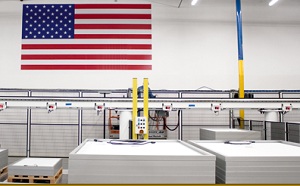SolarWorld more than triples production, adds polycrystalline to menu
 SolarWorld (SRWRF:US) has successfully increased its annual solar panel production from 150 megawatts per year to 500 megawatts per year at its Oregon and California Manufacturing facilities by adding polycrystalline solar panels to its United States product menu.
SolarWorld (SRWRF:US) has successfully increased its annual solar panel production from 150 megawatts per year to 500 megawatts per year at its Oregon and California Manufacturing facilities by adding polycrystalline solar panels to its United States product menu.
The move firmly secures the company as the country’s largest solar panel manufacturer, according to SolarWorld press releases.
SolarWorld has been producing monocrystalline solar panels in the U.S. for more than 20 years and decided in 2010 to ramp up production and bring polycrystalline into the fold, said Raju Yenamandra, the vice president of sales and business development for the company.
The company has manufacturing facilities here in the U.S. and in Germany, Yenamandra said.
“This gives us the option to pick from a range of technologies for our customers here in the U.S.,” Yenamandra said.
While monocrystalline solar photovoltaic modules tend to have higher efficiency ratings, the polycrystalline modules are typically less expensive and can be better suited for certain situations, Yenamandra said. When the company decided to expand production here, it seemed like a logical opportunity to incorporate the new technology, which the company had previously only manufactured in Germany.
The company started work in September 2010, achieved its goal of upping production to 500 megawatts a year in February and has successfully been producing the polycrystalline cells since the end of 2010, according to company’s press materials.
“We didn’t want to make announcements before the fact,” Yenamandra said. “There are so many announcements in the solar industry that don’t come to fruition. Our approach is: we did it, and this is what we have available.”
The inclusion of polycrystalline production does coincide with a disruption to the world’s polysilicon supply due to the disaster in Japan, resulting from a 9.0 magnitude earthquake on March 11, a tsunami and resulting nuclear crisis.
Yenamandra said the crisis in Japan should not impact SolarWorld’s polycrystalline production.
“Our raw materials, we get from a few places,” he said. “It’s mostly domestic from the U.S. for U.S. production and from Germany for Germany. I believe some of our supply comes from South Korea, but I don’t believe we get any products from Japan.”
Image courtesy of SolarWorld.



